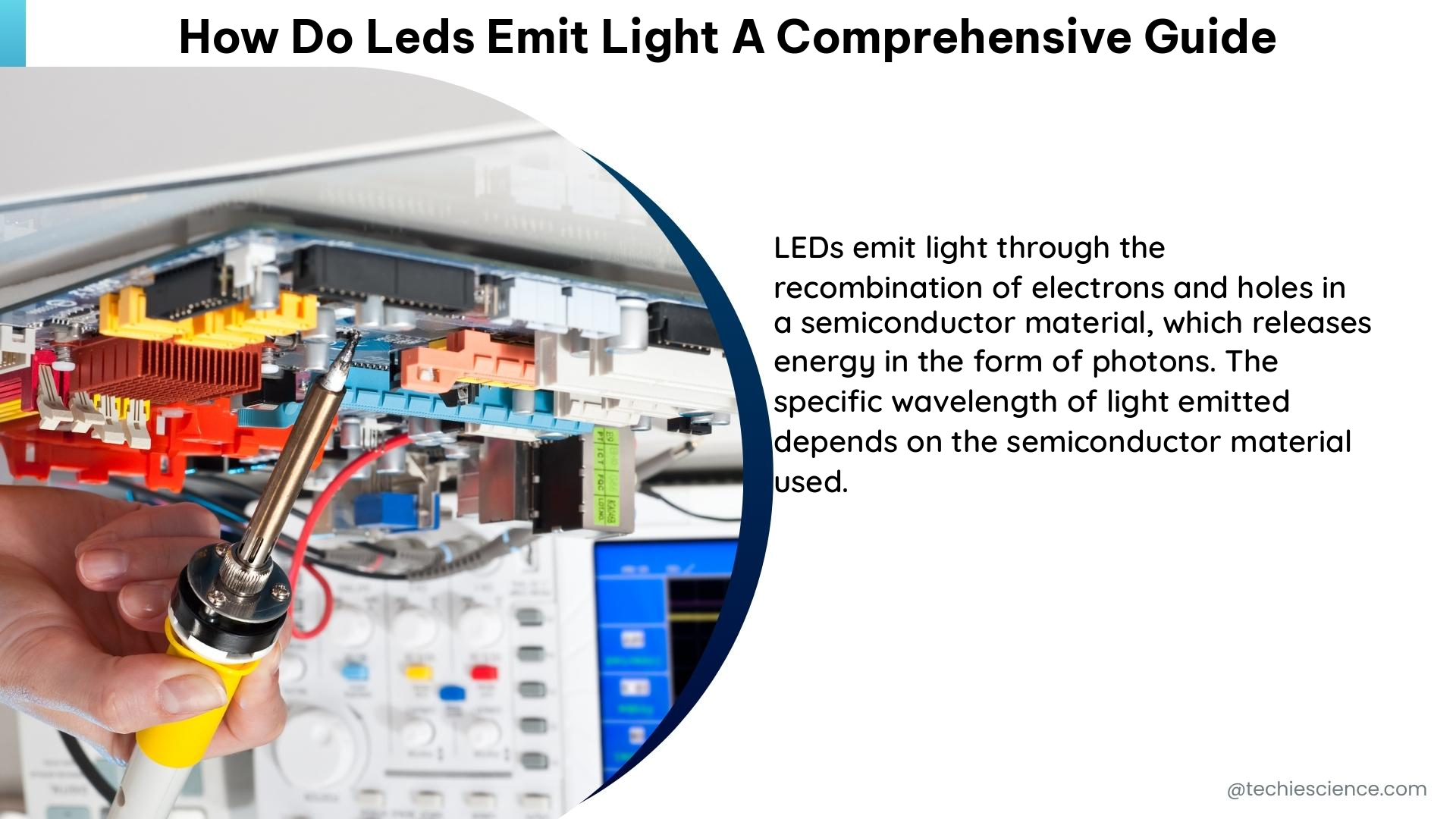LEDs, or Light Emitting Diodes, are semiconductor devices that convert electrical energy into light through a process called electroluminescence. This guide will provide a comprehensive understanding of how LEDs emit light, including the underlying principles, key parameters, and technical details.
The Principle of Electroluminescence in LEDs
The emission of light in LEDs is based on the principle of electroluminescence, which occurs when a semiconductor material is doped with impurities to create a p-n junction. When a voltage is applied across this junction, electrons from the n-type material move to the p-type material, filling “hole” states in the process. As the electrons recombine with the holes, they release energy in the form of photons, which are the basic units of light.
The specific semiconductor materials used in LEDs, such as gallium nitride (GaN) or indium gallium nitride (InGaN), have a bandgap energy that determines the wavelength of the emitted light. For example, GaN-based LEDs typically have a bandgap of around 3.4 eV, which corresponds to the emission of blue light, while InGaN-based LEDs have a bandgap of around 3 eV, which results in the emission of green light.
Key Parameters of LED Light Emission

The performance and characteristics of LEDs are determined by several key parameters, which are crucial for understanding how they emit light. These parameters include:
Luminous Efficacy
Luminous efficacy is a measure of the efficiency of an LED, which is the ratio of the total luminous flux (measured in lumens) to the total power input (measured in watts). The luminous efficacy of modern LEDs can be as high as 200 lumens per watt, making them significantly more efficient than traditional incandescent bulbs, which have a luminous efficacy of around 15 lumens per watt.
Luminous Intensity
Luminous intensity is a measure of the brightness of an LED, which is the amount of light emitted per unit solid angle (measured in candelas). The luminous intensity of an LED can range from a few candelas for small indicator LEDs to several thousand candelas for high-power LEDs used in automotive and lighting applications.
Viewing Angle
The viewing angle of an LED is the angle at which the luminous intensity of the device drops to 50% of its maximum value. The viewing angle can vary from as narrow as 10 degrees for highly directional LEDs to as wide as 180 degrees for omnidirectional LEDs, depending on the design and application.
Wavelength
The wavelength of the light emitted by an LED is determined by the bandgap energy of the semiconductor material used in its construction. This wavelength, measured in nanometers (nm), is a crucial parameter that determines the color of the emitted light. For example, red LEDs typically have a wavelength of around 620-630 nm, while blue LEDs have a wavelength of around 450-470 nm.
Technical Details of LED Light Emission
The process of light emission in LEDs involves several complex physical phenomena, which can be further explored in the following technical details:
Semiconductor Materials and Doping
The semiconductor materials used in LEDs, such as GaN and InGaN, are carefully engineered to have specific bandgap energies. These materials are then doped with impurities, such as silicon or magnesium, to create the p-n junction that is essential for the electroluminescence process.
Electron-Hole Recombination
When a voltage is applied across the p-n junction, electrons from the n-type material are injected into the p-type material, where they recombine with the “holes” (absence of electrons) in the valence band. This recombination process releases energy in the form of photons, which are the basic units of light.
Photon Emission and Wavelength
The wavelength of the emitted photons is determined by the bandgap energy of the semiconductor material. The energy of the photons is equal to the bandgap energy, which is the difference between the conduction band and the valence band of the semiconductor. This relationship between the bandgap energy and the photon wavelength is given by the equation:
E = hc/λ
where E is the photon energy, h is Planck’s constant, c is the speed of light, and λ is the wavelength of the photon.
Light Extraction and Efficiency
The efficiency of an LED in converting electrical energy into light is influenced by various factors, including the design of the device, the quality of the semiconductor materials, and the effectiveness of the light extraction mechanisms. Techniques such as the use of reflective surfaces, microlens arrays, and photonic crystals can enhance the light extraction and improve the overall efficiency of the LED.
Conclusion
This comprehensive guide has provided a detailed understanding of how LEDs emit light through the process of electroluminescence. By exploring the key parameters, such as luminous efficacy, luminous intensity, viewing angle, and wavelength, as well as the technical details of semiconductor materials, electron-hole recombination, and light extraction, you now have a comprehensive understanding of the principles and mechanisms behind LED light emission.
References
- Light Emitting Diodes (LEDs) for General Illumination, OIDA Technology Roadmap, November 2002.
- Measurement of LEDs, LED Professional, accessed on June 08, 2024.
- LED-based white light, ScienceDirect, accessed on June 08, 2024.
- Fundamentals of Solid-State Lighting: LEDs, OLEDs, and Their Applications in Illumination and Displays, Feng Sheng, CRC Press, 2015.
- LED Lighting: Technology and Perception, Martine Knoop, Wiley, 2015.

The lambdageeks.com Core SME Team is a group of experienced subject matter experts from diverse scientific and technical fields including Physics, Chemistry, Technology,Electronics & Electrical Engineering, Automotive, Mechanical Engineering. Our team collaborates to create high-quality, well-researched articles on a wide range of science and technology topics for the lambdageeks.com website.
All Our Senior SME are having more than 7 Years of experience in the respective fields . They are either Working Industry Professionals or assocaited With different Universities. Refer Our Authors Page to get to know About our Core SMEs.